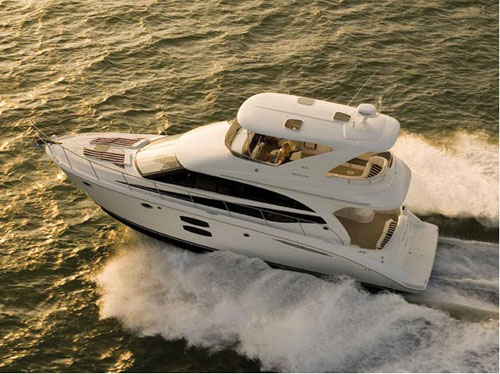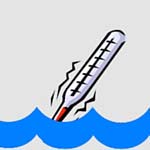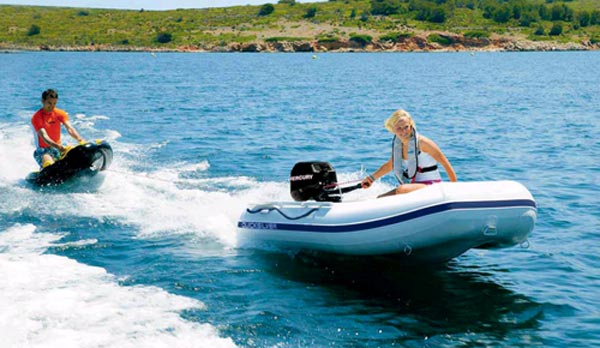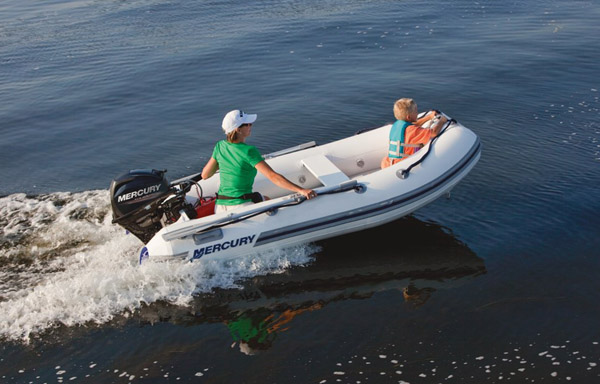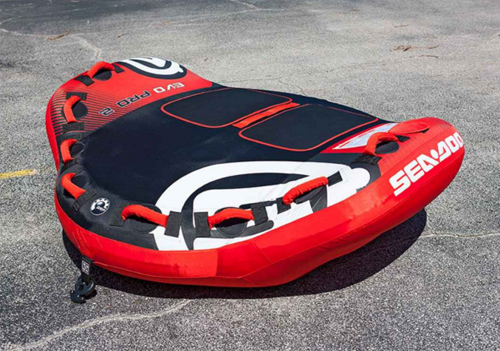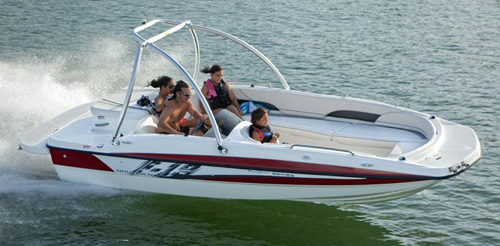Following are the Six Top Tow Tubes for adults and children for your adventure boating day or one day adventure picnic.
There’s something irresistible about the simple fun of an inflatable tow tube. Skis may be more challenging, a wakeboard capable of delivering more thrills, but the best bang for the buck in almost any towable arsenal is a marine accessory not very far removed from that old black inner tube many of us enjoyed as kids.
For starters “tubes,” as they’re known, prove incredibly versatile. Overweight or skinny, athletic or klutzy, young or old, nearly anyone can jump aboard and enjoy. There’s no real need for balance, no real learning curve. They deliver almost any kind of ride from mild to wild. But with a bewildering array available, which type should you choose?
We approached our selection the same way we imagine many families do — by loading a Web page and then asking our test subjects — 8- and 12-year-old sisters — to tell us what looked cool. We matched their selections against the “best-sellers” functions found on the Overton’s and West Marine websites and settled on a group of six: two each in one-, two- and three-passenger capacities. How’d they fare? Read on.
One-Passenger
Obrien Screamer Though it’s generations removed, you can feel the simplicity of that inner tube at the heart of Obrien’s best-selling Screamer. Its shape is the familiar circle, measuring 60 inches in diameter for the solo version. But unlike that inner tube, there’s no hole in the middle. A full nylon cover protects the inflatable PVC bladder within. Two large EVA (ethylene-vinyl acetate) pads lessen wear at contact points, as well as provide a softer layer against bare elbows and knees. Four padded grab handles offer a choice of handholds to keep the rider securely in position.
Like most tubes, the Screamer arrives already zipped into its removable cover. Inflation is quick and simple; a single Boston-style valve is used to inflate the entire tube. The Screamer’s tow point is a quick-disconnect tow hook. We gave it extra points for additional webbed grab-straps that ease carrying.
The Screamer may be simple, but our testers gave it enthusiastic thumbs up. The size lets the rider manipulate it easily, using body English to maneuver in and out of the wake. Its ample thickness cushions impact with the waves, increasing the fun factor for those riding up top. Simple? Absolutely. Still one heck of a lot of fun? Without a doubt.
Best for: All-purpose fun; great bang for the buck.
One-Passenger
Gladiator Sonix I The Gladiator Sonix I is more of a “ride-in” than “ride-on” tube. Like a mini rubber life raft, it features cockpit seating that’s perfect for those who would rather kick back and enjoy than be forced to hang on. An inflatable backrest provides some support; EVA knuckle guards are positioned below the Sonix’s two padded handles to avoid scrapes. The entire inflatable is fully covered by an outer nylon skin, with a sewn-in quick-connect tow point at the bow.
The Gladiator was perfect for our youngest tester after she was unceremoniously flung into the chilly water while testing another tube. Its relatively tame, controlled ride proved well matched to younger kids who might not want a full-on thrill ride, or older crewmembers who just feel like chilling. But the Sonix can get aggressive. Head for the wake and it jumps into the air like a sled on a ski hill. The catch? With a relatively thin inflatable floor, and the seated position preventing the rider from absorbing the shock, those landings can be a jolt on the back. Size is also a limitation. Though 60 inches in length, the generous inflatable collar limits the actual size of its cockpit, making it great for young kids but a tube that is hard-pressed to carry an adult in comfort.
Best for: Kids or smaller adults; those looking for a tamer ride.
Two-Passenger
Sea-Doo Evo Pro 2Sea-Doo’s 69-by-72-inch Evo Pro 2 stood out for both its shape and its side-to-side rocker. No donut, it resembles a stingray, yet this tube is devoid of the extraneous frills that often seem like overkill on multiple-passenger inflatables. Upward-curving wings give its bottom pronounced side-to-side curvature, reducing the wetted surface for more speed and allowing riders to roll the tube to angle back and forth across the wake. The wings also provide a certain sense of security. Get slingshot outside the wake, or butt up against it trying to come back in, and riders don’t feel as though the tube may flip. The result is a split personality and the ability to handle a wide range of ages and interests. Stay calm when desired, or take advantage of that minimal drag to go aggressive.
Like all of our test inflatables, the Evo Pro 2 came already assembled, with its PVC bladder protected by a heavy-duty nylon cover. A single Boston valve allows for quick inflation. No less than eight padded grab handles line the front edge, with neoprene knuckle guards below. That same neoprene protection is also featured in the knee and foot area to prevent wear — on both human and tube. A padded flap covers the valve opening.
Best for: All-around use; those who like a mix of speed and stability.
Two-Passenger
Airhead Revolution Our 12-year-old tester quickly dubbed the Airhead Revolution “so much fun!” —especially after it launched her younger sister, and later Mom, into the water. After repeated rides, however, even the Revolution’s most enthusiastic fan had endured just about enough. Such is the fate of a tube that spins its occupants in circles, much like Disney’s infamous teacup ride.
Yes, as the name implies, the 80-inch-diameter Revolution revolves … like a record, baby. A central tow point, featuring a heavy-duty stainless-steel swivel secured with Kevlar strapping, is located beneath the tube. Start to accelerate and multiple radius-length pockets, created by sewing a webbed support strap in half lengthwise, catch the water and commence the rotation. We found the speed of that rotation manageable at about 10 mph. Accelerate to 15 to 20 mph, however, and the rate of spin increases diabolically fast. Unless you’re relatively strong, the centrifugal force will win the fight.
Airhead has done what it can to keep riders in place. Riders lie across the Revolution in opposing directions, on opposite sides of an inflated central fin. Additional inflatable leg-holders are positioned between the riders’ knees, allowing them to use their legs for added grip. Padded grab handles feature neoprene knuckle guards below. The inner PVC bladder is fully protected by an 840-denier nylon cover, with neoprene panels up top in contact areas. Inflation is via a single Boston-style valve.
Yes, it’s possible not to spin. Just thread the tow rope through the “no-spin” strap. But what’s the fun in that?
Best for: Those who like a challenge — and have a strong stomach.
Three-Passenger
Rave Sports Ravenger PlusOur kid testers were immediately drawn to the Rave Sports Ravenger Plus, thanks to its similarity to another form of watery fun — a personal watercraft. Like a plumped-up PWC, the 90-by-64-by-33-inch Ravenger features a saddle, handlebars and footwells. One rider sits atop the saddle; two more can fit into the footwells, each of which features an inflatable floor.
The Ravenger was the lone inflatable in our test to not feature a full nylon cover. Instead, its 840-denier nylon wrap covers the bottom and sides, leaving the saddle, seat base, footwells, console and handlebars exposed. The exposed material is durable 30-gauge PVC, but it made us nervous bumping around the dock. The Ravenger was also the most taxing to inflate, because the main body, handlebars, footwell floors and backrests are all separate chambers.
As to the ride, it’s exceptionally stable, even with the full complement of passengers. The driver gets the cushiest treatment, thanks to the generous amount of inflated real estate below his or her bottom. Passengers don’t fare as well on the inflated floors, which transfer more of the bumps, don’t allow you to absorb shock with your legs, and are more in the line of spray coming off the hull. Our mom also dubbed the footwells too small for adult passengers. Still, our younger enthusiasts gave it the thumbs up — and loved the Rave Tail, a V-shaped plastic funnel attached to the stern that channels water up into a spray behind the inflatable as it’s pulled through the water.
Best for: Novelty factor; those who want a stable, leisurely ride.
Three-Passenger
SportsStuff Poparazzi It’s fair to say the SportsStuff Poparazzi was the most eagerly anticipated inflatable on hand. With its integrated arch, rockered bottom and in-your-face graphics, it just looks cool to the kids. Closer inspection reveals that the 72-by-68-inch base offers plenty of real estate for passengers to lie, sit, kneel or stand. Lay all three passengers below the arch, put two standing behind it, or mix up any combination of positions. Neoprene pads provide protection both to passengers and the tube along the floor. Padded grab handles, with neoprene knuckle guards, are at the ready in all forward positions to keep everyone hanging on. Additional webbed straps are located inside the arch for those who want to apply a little added leverage.
And you can leverage this tube. The rockered bottom and weight shifts generated by a standing passenger (or two) give the Poparazzi maneuverability. Ride it straight and it’s surprisingly stable. But throw that body weight around — especially when standing — and you can get things rocking and rolling, carving in and out of the wake.
The Poparazzi was the lone towable in our test to feature a speed valve. A simple two-part, plug-style valve, it allows inflation with anything from a Shop-Vac to a designated inflator. Pulling the larger, lower plug assists in quick deflation.
Best for: Multipassenger versatility; those who like the idea of teetering...as they’re tottering.
Proper Inflation TipsThe number-one mistake inflatable owners make, according to most manufacturers, is not filling their towable up with enough air.
When properly inflated, an inflatable should feel firm, not soft or squishy, to the touch. Its nylon outer cover should be free of wrinkles and should fit the inflatable like a second skin. Underinflation not only affects performance and longevity, but it also is a safety issue; if the cover doesn’t fit the tube tightly, riders may become entangled between the wrap and the bladder.
Ideally, choose a high-capacity, 110-volt inflater (like Airhead’s 3.0 psi electric Super Pump) to get the job done. The increased power will quickly inflate or deflate a tube in a matter of minutes. If you’re going to be inflating on the fly out on the water, look for models that can hook directly to the boat’s battery via alligator clips (like Airhead’s AHP-12HP), rather than using the 12-volt accessory plug. These will shorten the amount of time it takes to inflate.
While proper inflation is essential, don’t overdo it. Overinflation is the primary cause of damage to the PVC bladder and can result in ripped seams in the cover.
Choosing the Right Tow Line and AccessoriesWhile you may have a water ski or wakeboard tow line already in the boat, don’t scrimp on a dedicated tow line for your inflatable. Inflatables can put a massive amount of strain on a tow line and, as such, often need a greater breaking strength than a standard ski rope provides. Choose a tow line that best fits your tube’s passenger capacity. Most inflatable-specific lines are 60 feet in length, to position the tube in the ideal spot in the boat’s wake.
If the tow line frequently gets caught in the boat’s prop wash, consider SportsStuff’s Booster Ball ($109, sportsstuff.com). A 38-by-27-inch inflatable ball sandwiched in the middle of a 60-foot tow line, it enhances the performance of most inflatables by keeping the line out of the water, reducing drag, absorbing shock and reducing spray off the rope.
Anatomy of an Inflatable
PVC BladderThe actual “inflatable” portion of the tube, the PVC bladder is designed to hold in the air, cushioning the ride and, when properly inflated, improving the performance of the tube on the water. For two or more riders, a 30-gauge bladder is recommended. Avoid anything thinner, which will not offer the strength and puncture resistance necessary.
Nylon CoverTypically an 840-denier nylon, the cover protects the more vulnerable PVC bladder from punctures and damage, improves the performance by offering a smooth surface against the water, and is a canvas for colors and graphics. Covers should fit tightly, with minimal slack or puckering. Additional EVA or neoprene pads are often featured in high-wear areas. Seams should be double-stitched. Avoid polyester, which does not have the required tear strength.
Grab HandlesLook for multiple grab handles sewn into the cover to keep your passengers aboard. Rather than simple webbed straps, modern handles are typically rounded and padded to ease strain on bare, wet hands. Neoprene knuckle uards, positioned below each handle, avoid scuffs against the rougher nylon wrap.
ValvesValves allow for rapid inflation and deflation of the inflatable bladder, and are typically accessed through padded flaps in the nylon cover. Boston-style valves are most common. They feature a one-way valve with two caps. Unscrew the smaller cap for inflation; unscrew the entire valve assembly from the tube to rapidly deflate. Tip: If you ever want to get the tube as tightly packed as it comes from the manufacturer, don’t simply unscrew the valve. Instead, reverse the direction of your inflator and suck as much air as possible out of the tube.
Quick-Connect Tow HookThe attachment points that connects tube to tow rope, most tow hooks are made of a durable nylon and allow for quick attachment and detachment to and from the tow line without binding. Tow hooks are commonly anchored to a webbed strap, which is sewn directly into the nylon cover with reinforced stitching.
Regal 27 FasDeck RX
LOA: 27’3
Beam: 8’6”
Draft: 3’0”
Displacement (approx.): 5,460 lb.
Regal Boats Orlando, Florida; 800-877-3425; regalboats.com
We had boatbuilders clamoring to participate in our tow tube test. We chose Regal’s 27 FasDeck RX for a number of reasons. As a deck boat, it maximizes cockpit space and features broad boarding platforms fore and aft, features that make it perfect for carrying a big crew and all the gear for a day of tubing. An enclosed head ensures the crew is comfortable. Its FasTrac hull planes flat, remains maneuverable at slower speeds, and maximizes fuel efficiency. Fitted with an electrically folding “power tower,” a Fusion audio system with six speakers, and arena seating, our tube testing proved the 27 FasDeck RX is an ideal family do-it-all boat.
To
Hire A Yacht For One Day Adventure Picnic In Mumbai India Contact Us @ 022 66776659
Source - boatingmag.com
